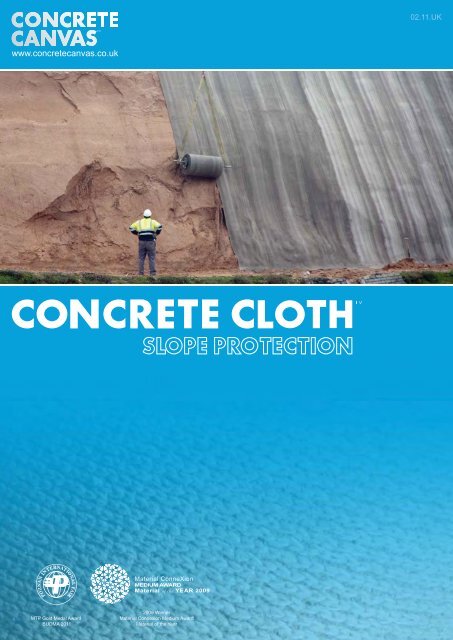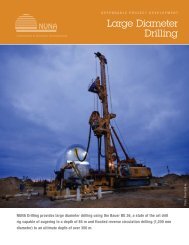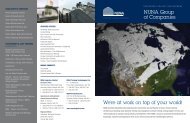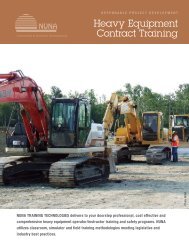1011 CC Mining.ai - Nuna Logistics
1011 CC Mining.ai - Nuna Logistics
1011 CC Mining.ai - Nuna Logistics
You also want an ePaper? Increase the reach of your titles
YUMPU automatically turns print PDFs into web optimized ePapers that Google loves.
POZNAN INTERNATIONAL FAIR<br />
02.11.UK<br />
TM<br />
www.concretecanvas.co.uk<br />
Material ConneXion<br />
MEDIUM AWARD<br />
Material of the YEAR 2009<br />
MTP Gold Medal Award<br />
BUDMA 2011<br />
2009 Winner<br />
Material Connexion Medium Award<br />
Material of the Year
Concrete Impregnated Fabric...<br />
<strong>CC</strong> Slope Stabilisation<br />
Application and Case Study<br />
21.12.10 Case Study : Alcobendas Station, Madrid, Sp<strong>ai</strong>n<br />
In December 2010, ADIF, the Spanish authority responsible for r<strong>ai</strong>lway infrastructure management, specified Concrete Cloth (<strong>CC</strong>) to be used as<br />
slope stabilisation to protect a r<strong>ai</strong>lway station in Madrid. <strong>CC</strong> was chosen to address years of erosion and instability issues affecting the entrance of<br />
Alcobendas tunnel station. Erosion of the steep r<strong>ai</strong>lway slope trenches had caused silting at the dr<strong>ai</strong>nage pumps in the tunnel entrance. Shotcrete<br />
has long been the traditional solution, but presents several problems with installation and durability.<br />
<strong>CC</strong>8 was specified and 2500sqm of material was delivered on site in bulk rolls. The project’s first phase of 800sqm was completed in under 3 days<br />
and was 70% quicker to install than if shotcrete had been used.<br />
View of 40% completed project<br />
Alcobendas tunnel station<br />
<strong>CC</strong> applied with spreader beam<br />
Hydration of the <strong>CC</strong><br />
Terminating <strong>CC</strong> into a dr<strong>ai</strong>nage channel<br />
For technical support contact Concrete Canvas SA:<br />
www.concretecanvas.co.za<br />
TM<br />
+27 83 325 9001 greg@concretecanvas.co.za<br />
www<br />
www.concretecanvas.co.za<br />
© Concrete e Canva<br />
anvas sLtd 2011
Concrete Impregnated Fabric...<br />
<strong>CC</strong> Slope Stabilisation<br />
Application and Case Study<br />
03.08.10 Case Study : F<strong>ai</strong>rlight Cove, East Sussex<br />
In June 2008 Rother Council commissioned a major coastal protection<br />
project at F<strong>ai</strong>rlight Cove on the south coast of England. The area has<br />
suffered from extreme landslide regression resulting in the loss of<br />
residential property and further threatening a large number of<br />
dwellings.<br />
<strong>CC</strong>4 (4mm Concrete Cloth) was specified by Rother Council’s<br />
geotechnical consultants to stabilise and protect a sub-vertical f<strong>ai</strong>lure<br />
surface close to a key dr<strong>ai</strong>nage facility. The steep nature of the slope<br />
prevented conventional slope stabilisation techniques such as<br />
vegetation growth. The Cloth was supplied as man-portable rolls<br />
allowing work to be completed in areas with restricted access and<br />
where conventional concreting would be impossible.<br />
“Concrete Cloth allowed us to quickly and effectively provide<br />
protection to a slope which was experiencing ground movement. The<br />
site was particularly difficult as it was on an exposed coastal cliff top<br />
and steep slope. The Concrete Cloth was l<strong>ai</strong>d in less than a day and<br />
without the need for heavy plant machinery, and also allowed the<br />
provision of an access ramp and superficial dr<strong>ai</strong>nage. We would<br />
recommend its use to anyone facing similar challenges with slope<br />
stabilisation.”<br />
Dr. Jacqueline Skipper, Senior Geologist,<br />
Geotechnical Consulting Group<br />
For technical support contact Concrete Canvas:<br />
www.concretecanvas.co.uk<br />
TM<br />
+44 (0) 845 680 1908 info@concretecanvas.co.uk<br />
www<br />
www.concretecanvas.co.uk
Concrete Impregnated Fabric...<br />
TM<br />
<strong>CC</strong> Slope Stabilisation<br />
Case Study<br />
Concrete Cloth Slope Protection<br />
<strong>CC</strong> Slope Protection demonstration, Jeddah, Saudi Arabia<br />
Slope weather protection is important to control soil erosion down slope as a result of direct r<strong>ai</strong>nfall and surface runoff. Protection can be a permanent<br />
slope covering or a temporary measure until the excavation has been backfilled. Uncovered slopes undergo surface ravelling and gulleying, leading<br />
to instabilities and safety concerns. Soil erosion is normally prevented by applying a thin concrete skin. However, this is difficult to apply uniformly<br />
and often breaks apart. Plastic sheeting covers are disturbed by strong winds, water flows or site damage and meshes do not provide the same level<br />
of direct weather protection.<br />
Concrete Cloth (<strong>CC</strong>) provides a quick means to directly apply a thin, uniform, protective concrete covering to the slope surface and can be applied<br />
in all weather conditions. <strong>CC</strong> is fixed by short n<strong>ai</strong>ls and provides a strong, waterproof, surface stabilising covering enhanced by internal reinforcing<br />
fibres. <strong>CC</strong> can be used in conjunction with full length soil n<strong>ai</strong>ls to increase the stability of slope surfaces by providing similar slope protection<br />
measures. <strong>CC</strong> can also be used to cover landslide scars or cut slopes. Holes can be cut to allow vegetation growth.<br />
<strong>CC</strong>4 or <strong>CC</strong>8 in rolls of 200sqm or 125sqm respectively<br />
can be handled & positioned using site plant.<br />
<strong>CC</strong> is rolled from the slope crest down the slope face,<br />
with 100mm overlaps between adjacent <strong>CC</strong> sheets.<br />
<strong>CC</strong> is cut to length, depending on the slope size.<br />
Short lengths of <strong>CC</strong> can be provided in man portable<br />
lengths for manual application.<br />
<strong>CC</strong> is fixed using short n<strong>ai</strong>ls hammered into the soil.<br />
Other fixing methods such as drilled bolts can also be<br />
used if rock is present.<br />
<strong>CC</strong> is hydrated once fixed into position. Lined dr<strong>ai</strong>ns<br />
can be formed from <strong>CC</strong> at the slope crest and toe.<br />
For technical support contact Concrete Canvas:<br />
www.concretecanvas.co.uk<br />
TM<br />
+44 (0) 845 680 1908 info@concretecanvas.co.uk<br />
www<br />
www.concretecanvas.co.uk<br />
© Concrete Canvas Ltd 2011
Concrete Impregnated Fabric...<br />
<strong>CC</strong> <strong>Mining</strong><br />
Application and Case Study<br />
<strong>CC</strong> <strong>Mining</strong> - Application and Case Study<br />
Concrete Cloth’s cementitious fabric properties provides a new solution to<br />
Mines and <strong>Mining</strong> operation both above and below ground. It can be used<br />
as an alternative to poured or sprayed concrete or as a quick way of<br />
erecting strong permanent or temporary blast and vent structures.<br />
Concrete Cloth’s fabric roll form provides a fast alternative that solves the<br />
logistical difficulties associated with these methods.<br />
The prefabricated nature of Concrete Cloth means that it can be easily<br />
transported and stored underground. It can be supplied in man-portable<br />
rolls and quickly and easily fixed to the rock face using standard power<br />
tools such fixing methods.<br />
Applications for mining include:<br />
• Spall Lining – Substrate stabilisation, fire resistant to Euroclass B<br />
• Ventilation structures – Quickly constructed over a timber frame<br />
• Blast walls – Ready in less than 24 hours<br />
• Dr<strong>ai</strong>nage and water management<br />
• Ground Stabilisation<br />
• Pipe protection<br />
Miners and contractors in platinum mine, South Africa<br />
The two images to the right show a successful <strong>CC</strong> vent wall trial conducted<br />
in the Gloria Mine in Mpumalanga for Optimum Coal <strong>Mining</strong>, via our South<br />
African distributor, Concrete Canvas SA in November 2010.<br />
<strong>CC</strong> vent wall<br />
For technical support contact Concrete Canvas:<br />
www.concretecanvas.co.uk<br />
+44 (0) 845 680 1908 info@concretecanvas.co.uk<br />
www<br />
www.concretecanvas.co.uk<br />
© Concrete Canvas Ltd 2010
Concrete Impregnated Fabric...<br />
<strong>CC</strong> Weed Inhibiting<br />
Case Study<br />
Case Study : <br />
In December 2010 Concrete Cloth was trialled to inhibit weed growth beneath a set of steel seawall steps. The steps provide Environment Agency<br />
(EA) operatives safe access up/down their seawall embankments to structures such as sluices and pumping stations. The steps had an open tread<br />
mesh which allowed grass to grow up from beneath rendering the steps unsafe due to possible slippage.<br />
The grass and vegetation below the steps could not be removed using strimming equipment and herbicides were discounted as many of the<br />
seawalls that the st<strong>ai</strong>rs gave access to were environmentally designated sites (SSSI, RAMSAR, SPA, SAC etc.) and had nearby water. The decision<br />
was reached that the best way to prevent grass growth was to suppress the area beneath the st<strong>ai</strong>r access. A layer of geotextile or filter cloth was<br />
considered but it was thought that this would degrade in UV and wouldn’t provide a long term solution. <strong>CC</strong>4 was chosen instead for its durability and<br />
protection from weathering and UV degradation. The Cloth was installed quickly, by removing several of the step treads and unrolling a 10sqm<br />
batched roll down the embankment. This was advantageous as the steps did not have to be fully removed which saved on time and did not require<br />
plant equipment.<br />
The project was considered a success and plans are being considered to apply Concrete Cloth to a number of other seawall step sites.<br />
<br />
Vegetation growth<br />
<strong>CC</strong> provided in batched rolls<br />
Completed st<strong>ai</strong>r access<br />
Unrolling <strong>CC</strong> into position<br />
For technical support contact Concrete Canvas:<br />
www.concretecanvas.co.uk<br />
+44 (0) 845 680 1908 info@concretecanvas.co.uk<br />
www<br />
www.concretecanvas.co.uk<br />
© Concrete Canvas Ltd 2010
Concrete Impregnated Fabric...<br />
<strong>CC</strong> Pipeline Protection<br />
Application and Case Study<br />
Concrete Cloth Pipe Protection<br />
Concrete Cloth (<strong>CC</strong>) can be used as practical, simple to install coating<br />
for pipeline protection. <strong>CC</strong> is flexible prior to hydration and can be<br />
wrapped around the pipe to provide mechanical protection, negative<br />
buoyancy and backfill protection of anti corrosion coatings.<br />
<strong>CC</strong> pipe protection<br />
The unique properties of <strong>CC</strong> make it suitable for the most demanding<br />
pipeline applications. In remote areas it can be used to coat steel pipe<br />
on site without setting up expensive fixed wet concrete application<br />
plants. It can be used wherever the following properties are required:<br />
• Rapid strength g<strong>ai</strong>n.<br />
• High impact and tear resistance.<br />
• Abrasion and sag resistant when hardened.<br />
• Heat resistant for high temperature or fire proofing applications.<br />
• Chemically resistant for situations subject to chemical attack in<br />
aggressive soil conditions or in inter tidal marine areas.<br />
• Underwater setting (including seawater), ideal for subsea<br />
applications<br />
04.10.10 Case Study : Doha, Qatar<br />
Iberdrola, an international energy company, commissioned Doha<br />
Engineering Services Co. to provide protection for a 1200m shallow<br />
water pipeline carrying water and chlorine for their facility in Qatar.<br />
Trial <strong>CC</strong> wrapping<br />
<strong>CC</strong>13 was specified to provide impact protection and negative<br />
buoyancy to the 6” diameter PVC pipe.<br />
The <strong>CC</strong> was installed in-situ at a depth of 5m below tidal waters. Divers<br />
were able to line approximately 60m of pipeline per day. The <strong>CC</strong> was<br />
cut into sections on site which were latitudinally wrapped around the<br />
pipe and fixed in position using heavy duty cable ties. <strong>CC</strong> can be<br />
hydrated using seawater, so the Cloth set underwater providing a<br />
durable and impact resistant protection.<br />
“The end customer was extremely satisfied with the speed and ease of<br />
use of <strong>CC</strong>. There was no other material that could have been used to<br />
provide underwater pipeline protection in this way.”<br />
S. Raghavendra<br />
General Manager, Doha Engineering Services CO. WLL<br />
<strong>CC</strong> fixed using heavy duty cable ties<br />
Completed <strong>CC</strong> pipeline protection<br />
For technical support contact Concrete Canvas:<br />
www.concretecanvas.co.uk<br />
+44 (0) 845 680 1908 info@concretecanvas.co.uk<br />
www<br />
www.concretecanvas.co.uk<br />
© Concrete Canvas Ltd 2010
Concrete Impregnated Fabric...<br />
<strong>CC</strong> Curb Rep<strong>ai</strong>r<br />
Case Study<br />
12.01.11 Case Study : Curb Rep<strong>ai</strong>r<br />
In January 2011, Miller Capilano Highway Services were commissioned via our Canadian distributor, <strong>Nuna</strong> Innovations, to trial the use of Concrete<br />
Cloth (<strong>CC</strong>) to rep<strong>ai</strong>r damaged curbs. The void in the curb was first filled and then lined with <strong>CC</strong>8. The <strong>CC</strong> was wrapped around the curb and fixed<br />
into position using standard concrete anchor screws before hydrating. Following the success of the trial, which was completed in under two hours,<br />
a number of other curb sites are being considered for refurbishment using <strong>CC</strong>.<br />
Damaged curb section at m<strong>ai</strong>n junction<br />
Damaged curb section det<strong>ai</strong>l<br />
Completed, refurbished curb section<br />
For technical support contact Concrete Canvas:<br />
www.concretecanvas.co.uk<br />
+44 (0) 845 680 1908 info@concretecanvas.co.uk<br />
www<br />
www.concretecanvas.co.uk<br />
© Concrete Canvas Ltd 2010
Concrete Impregnated Fabric...<br />
<strong>CC</strong> Slope Stabilisation<br />
Case Study<br />
21.12.10 Case Study : Alcobendas Station, Madrid, Sp<strong>ai</strong>n<br />
In December 2010, ADIF, the Spanish authority responsible for r<strong>ai</strong>lway infrastructure management, specified Concrete Cloth (<strong>CC</strong>) to be used as<br />
slope stabilisation to protect a r<strong>ai</strong>lway station in Madrid. <strong>CC</strong> was chosen to address years of erosion and instability issues affecting the entrance of<br />
Alcobendas tunnel station. Erosion of the steep r<strong>ai</strong>lway slope trenches had caused silting at the dr<strong>ai</strong>nage pumps in the tunnel entrance. Shotcrete<br />
has long been the traditional solution, but presents several problems with installation and durability.<br />
<strong>CC</strong>8 was specified and 2500sqm of material was delivered on site in bulk rolls. Using a crane mounted with a spreader beam to position the <strong>CC</strong>, the<br />
project’s first phase of 800sqm in under 3 days.<br />
View of 40% completed project<br />
Alcobendas tunnel station<br />
<strong>CC</strong> applied with spreader beam<br />
Hydration of the <strong>CC</strong><br />
Terminating <strong>CC</strong> into a dr<strong>ai</strong>nage channel<br />
TM<br />
For technical support contact Concrete Canvas:<br />
www.concretecanvas.co.uk<br />
+44 (0) 845 680 1908 info@concretecanvas.co.uk<br />
www<br />
www.concretecanvas.co.uk<br />
© Concrete Canvas Ltd 2010










